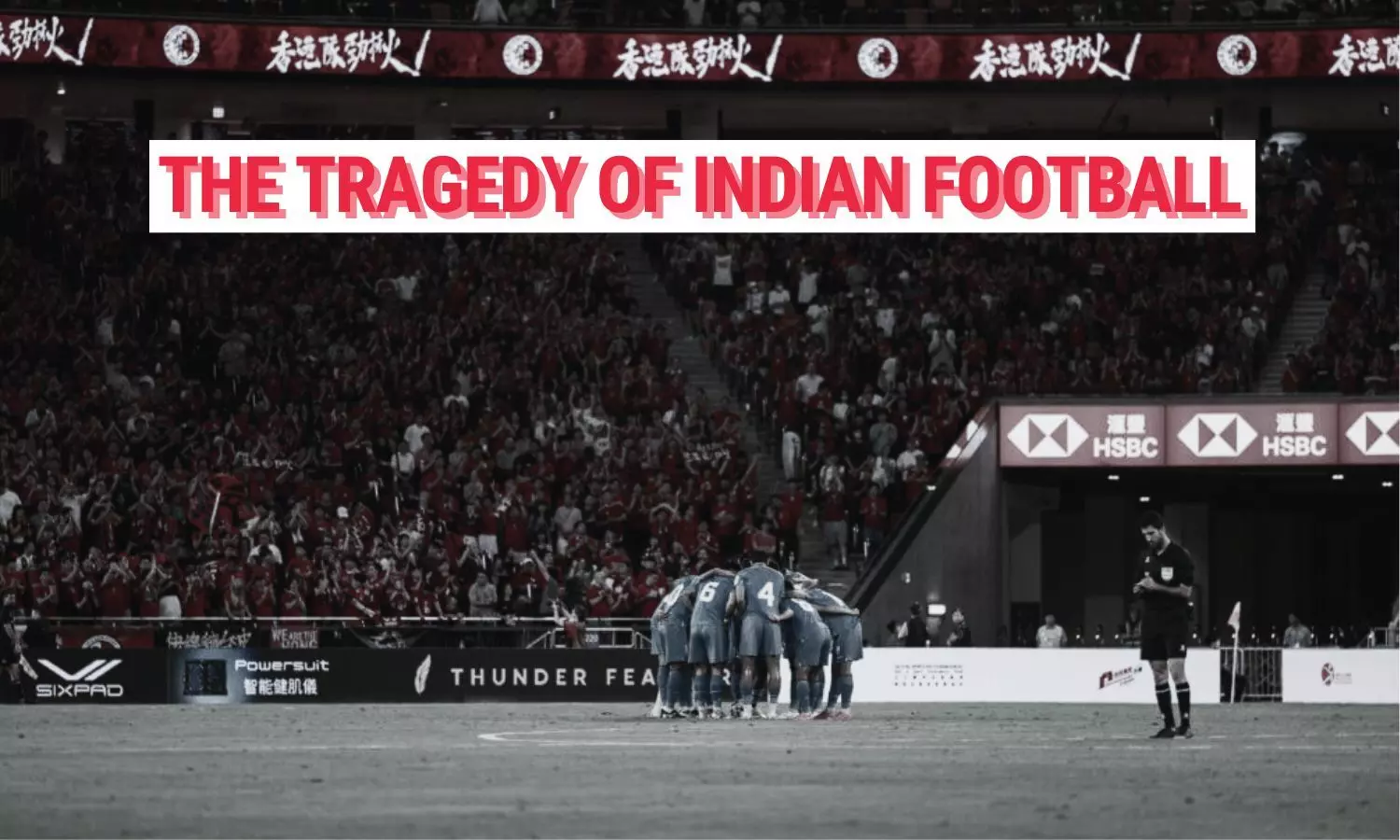Football
Offside by design: The tragedy of Indian Football
From overpaid players to systemic flaws and a lack of accountability, Indian men’s football is stuck in a cesspool.

Indian men’s football is going through one of its most frustrating eras.
The national team recently lost 0–1 to Hong Kong in the AFC Asian Cup qualifiers — a result that not only sums up the current level of performance but also exposes a deeper rot within the system.
The response after the defeat was a rare moment of honesty: a few club owners and senior stakeholders came out admitting that they too were part of the problem.
But this fleeting self-awareness does little to change a system that’s showing signs of long-term structural failure.
As of June 2025, India’s FIFA ranking stands at 133, just two positions above its worst-ever ranking of 135 from 2016 in the last 10 years.
While nations like Jordan have transformed their fortunes and punched their ticket to the World Cup, India is struggling to even secure a consistent place in the Asian Cup.
So, what is wrong with Indian men’s football?
Coaches aren’t magicians
Indian football’s favorite scapegoat is the head coach. From Stephen Constantine to Igor Štimac and now Manolo Márquez, every coach has faced criticism, leading to an eventual dismissal or resignation.
However, all signs point to a deeper issue.
When three drastically different coaches, with varied tactical approaches and man-management styles, fail to extract consistent performances, it is no longer just a coaching issue.
Manolo Márquez’s appointment as India’s head coach on July 20, 2024, brought optimism.
Known for his work with Hyderabad FC and later FC Goa, Márquez had a proven track record in Indian football, especially with developing young players.
However, since his appointment, India has played 7 games under his leadership, winning just once (a 3-0 win over the Maldives), drawing four, and losing the rest.
His tenure has already been marred by criticism, particularly regarding his dual role with FC Goa and the national team.
This raises an ethical and logistical conflict: Can one serve two masters—club and country—with equal commitment? The answer is becoming increasingly obvious: no.
It is a structural failure in how we perceive national coaching duties in India. The national team management cannot be a side gig.
But here is the bigger question: If even a coach like Márquez, with all his understanding of Indian football and proven capabilities, is failing to get results, maybe the problem isn’t the coach.
Maybe we have reached a stage where no coach, no matter how qualified, can succeed with the tools currently available.
The real question is: are Indian players good enough to compete at the Asian level? If not, then what is being done to improve that? So far, the answer has been “very little.”
Player accountability is no longer optional
Too often, the narrative around Indian football failures focuses exclusively on coaching strategies or federation policies, while the players remain untouched.
But the truth is, Indian players lack consistency, motivation, and basic technical ability.
The lack of passion on the pitch is palpable. Interviews are packed with rhetoric about the “privilege of playing for India”, and yet the performances do not reflect that sentiment.
Stringing together three passes seems like a monumental task. The body language is often defeatist, and there is a growing dissonance between what players say and how they perform.
Even veterans shy away from accountability on most days. There is radio silence after defeats—no post-match reflections, no attempts to connect with disillusioned fans. It was only Sandesh Jhingan who spoke up after the Hong Kong defeat.
While social media isn’t the only measure of accountability, the complete absence of player-led discourse following national team failures is troubling.
It is time to ask if the players are committed to the national cause, or are they simply clocking in and out between club matches?
Inflation of wages, shrinking of talent
Indian football is dealing with a bizarre economic distortion: players are being paid inflated salaries while delivering underwhelming performances.
Some Indian Super League (ISL) players now earn more than their counterparts in Europe’s second and third divisions — an unsustainable model that discourages both development and discipline.
This wage inflation has prompted clubs to stop investing in grassroots development. Instead, they turn to the transfer market, creating a small pool of players who are passed around in a game of musical chairs.
No new talent is truly being integrated; the same group of players rotate through different teams, with very little upward pressure or challenge from a younger generation.
The system has created an artificial bubble where players, agents, and clubs, all benefit from short-term gains while the national team continues to suffer from long-term stagnation.
Many promising players are skipping the developmental phase entirely — bypassing I-League stints and jumping straight into ISL contracts, drawn by glamour and money.
Coaches like Bibiano Fernandes (U17) and Naushad Moosa (U20) have openly admitted that this rush to the top is hurting development.
It is a system where patience is punished, and instant gratification is rewarded.
The result? Players sign for ISL clubs and then rot on the bench, missing out on the developmental years where actual game time is irreplaceable.
There is a clear lack of structured progression:
• U15 → U18 → I-League → ISL → National Team is not followed.
• Instead, the trajectory is warped: U18 → ISL → Bench → Irrelevance.
This “musical chairs” dynamic, where the same pool of 30–40 players circulate among clubs, is harming Indian football’s long-term prospects.
Media cannot speak — even when it must
There’s a common complaint that Indian football media does not ask tough questions. But the truth is more complicated. In India, media freedom, even in sport, is under siege.
When a journalist criticizes a player, agents reach out, questioning if a club paid them to lower the player’s market value.
Clubs discourage open criticism, fearing it will affect morale or branding. As a result, coverage turns into PR puffery.
You cannot solve a crisis that you cannot talk about. And when the media are muzzled, accountability disappears, and complacency thrives.
In such an environment, how can any ecosystem evolve?
Fans: Passion without perspective
Indian football fans are among the most passionate in Asia, but also some of the most divided. Club rivalries dominate online spaces, and unfortunately, that tribalism leaks into the national team ecosystem.
If a player from Club A underperforms, fans from Club A will defend him aggressively, while those from Club B will attack him, not as an Indian player, but as a club rival. The national team becomes a battleground of club loyalties, not a symbol of unity.
Fans must shift their mindset:
• From “my club player vs your club player” to “our national team player”.
• From reactionary outrage to constructive support and pressure.
True support includes demanding better, not just cheering louder.
The Federation: A black hole of accountability
The All India Football Federation (AIFF) has released ambitious blueprints like Vision 2047, aiming to make India a top-10 Asian team. But these dreams are wildly out of sync with reality.
In the last three years alone, there have been more corruption scandals than competitive wins. Grassroots programs are inconsistent, national team calendars are poorly planned, and there is very little communication or transparency with fans or stakeholders.
The federation’s priority appears to be event optics and international tie-ups, rather than fixing domestic systems.
Vision documents are meaningless unless the groundwork is laid—and that requires sustained investment in grassroots football, a robust scouting network, and transparency.
OCI/PIO players are not the silver bullet
Every time India suffers a humiliating defeat, the chorus grows louder: “Bring OCI/PIO players.”
While the idea sounds tempting, especially considering countries like Saudi Arabia and Qatar have benefited from naturalized talent, the Indian context is vastly different.
First, systemic issues cannot be solved by importing players. The same problems that plague India-born players — lack of coordination, motivation— will eventually impact any new players brought into the fold.
More importantly, if those born and brought up in India aren’t inspired enough to represent the country at full commitment, what guarantees are there that OCI/PIO players will?
Even if such players are brought in, there is the question of money. Will the federation or clubs be willing to pay premium wages to keep these players interested and motivated long-term?
If the answer is no, then what exactly can they be offered?
Pride alone may not be enough to carry a player through, especially when the existing infrastructure, coaching support, and performance environment remain below par.
Time to walk the talk
Indian football’s problems are layered, but interconnected:
• A federation marred by inefficiency
• A player pool that lacks discipline and direction
• A system that rewards mediocrity
• Fans and media that are unable or unwilling to enforce accountability
What is happening in Indian men’s football is not a temporary blip — it is a culmination of years of neglect, inflated egos, short-sighted policies, and lack of accountability.
Fixing it will require more than importing a few foreign players or hiring a tactically sharp coach.
It will need a cultural shift.
Players must be held to higher standards. Clubs must be incentivized to build and not just buy. The federation needs to be more transparent, and fans must learn to support the badge over individual allegiances.
Until then, India’s FIFA ranking will continue to hover at the bottom, while other nations, with less money but more vision, continue to leave us behind.
It is time to walk the talk.

